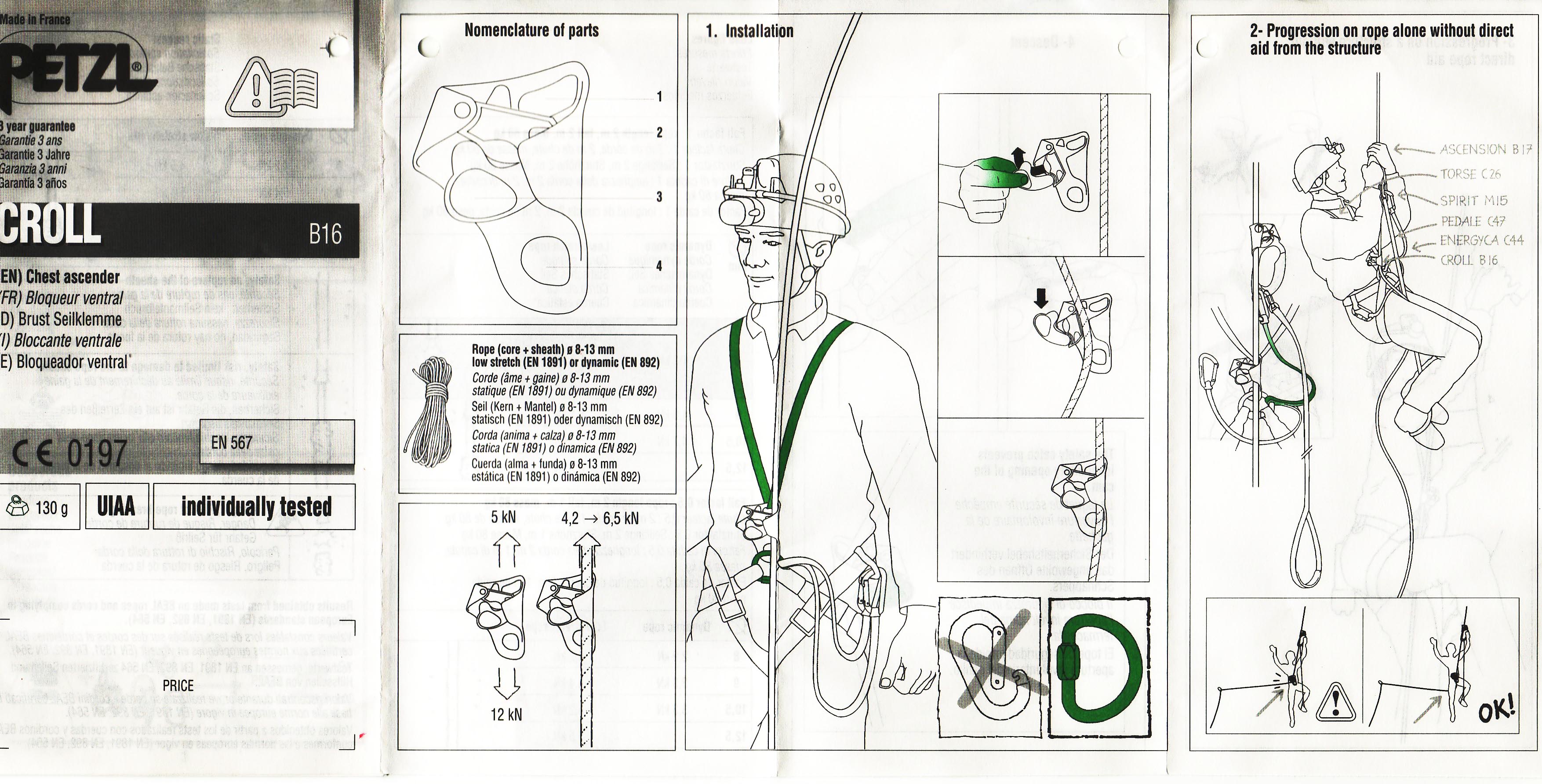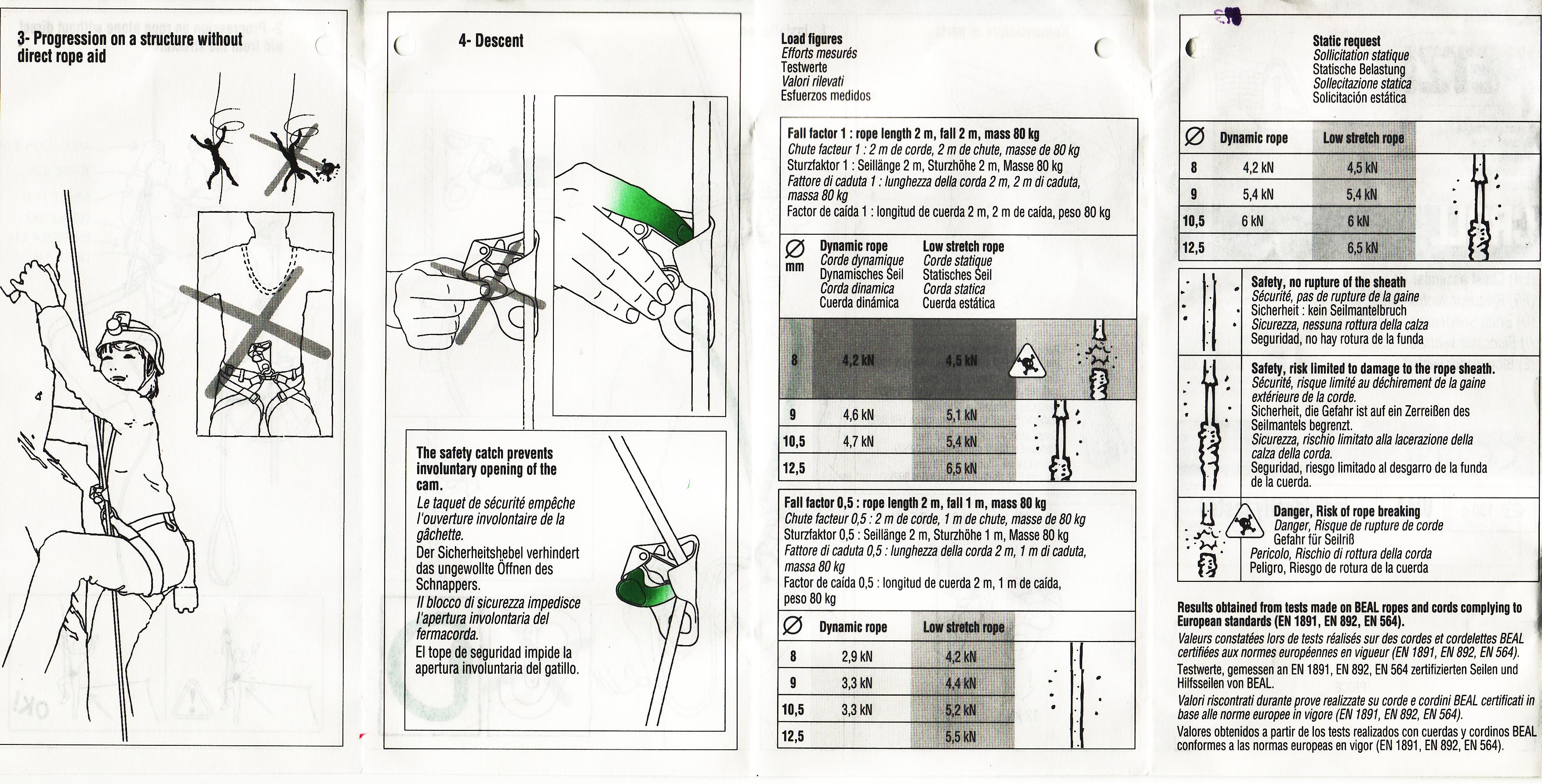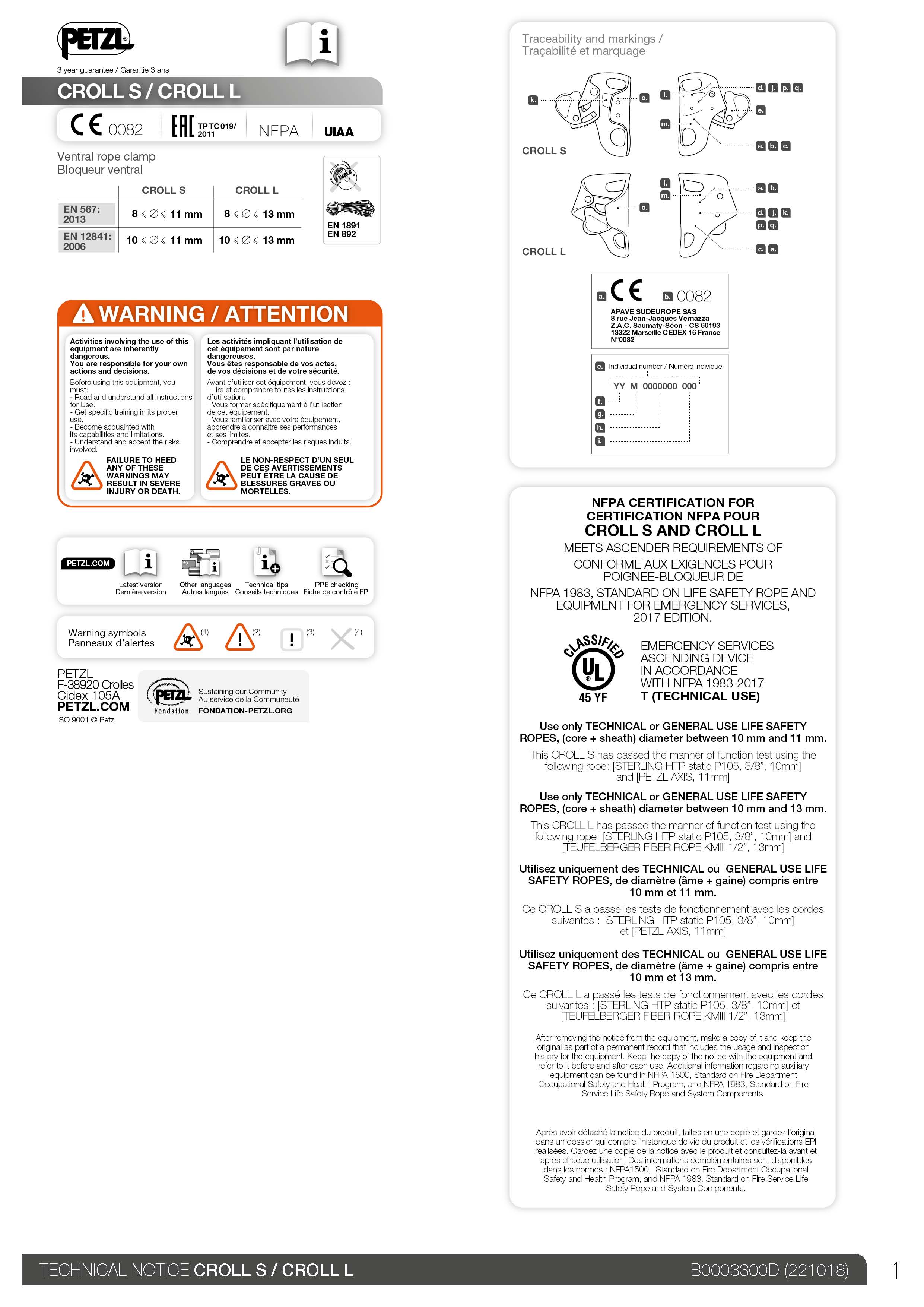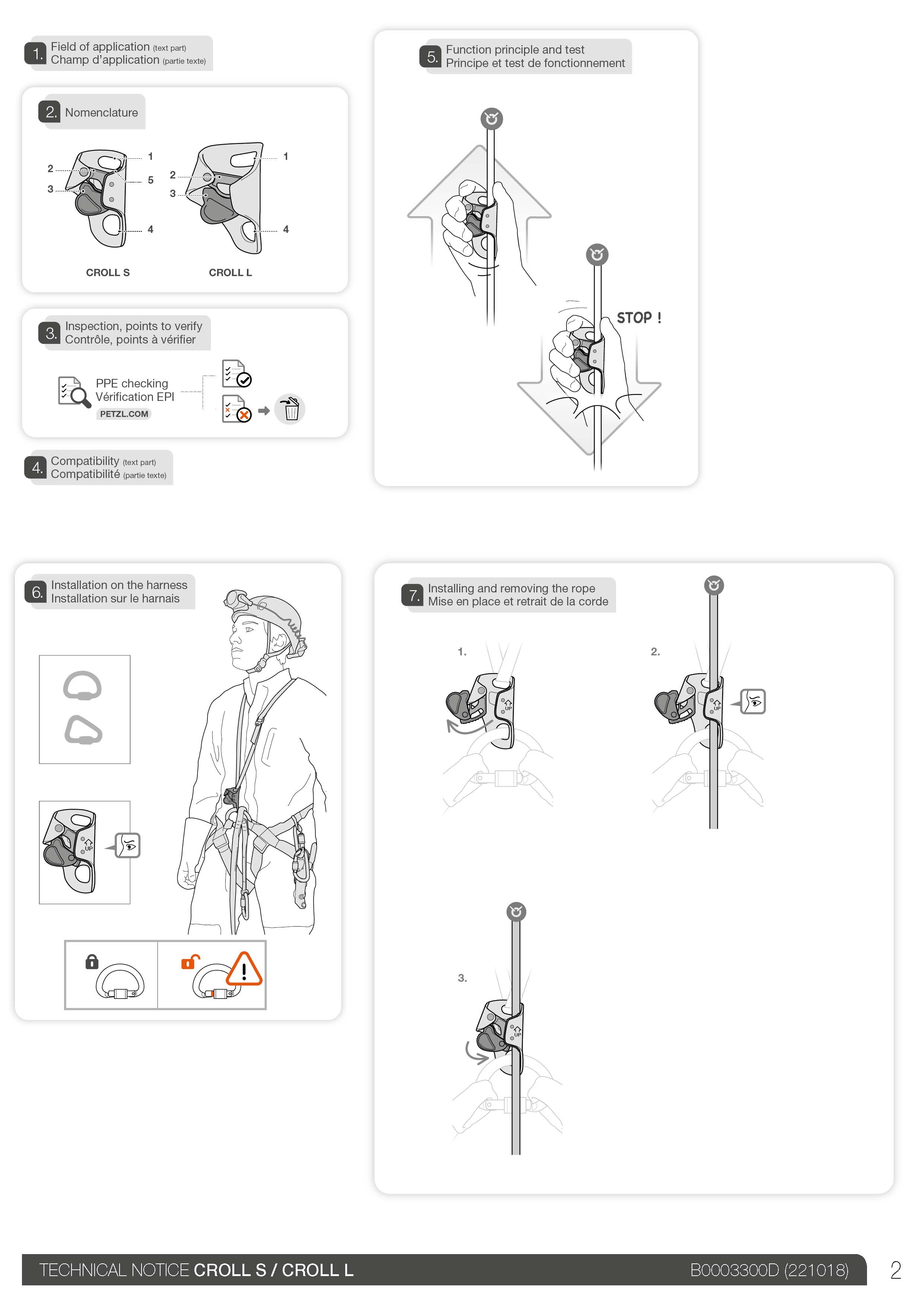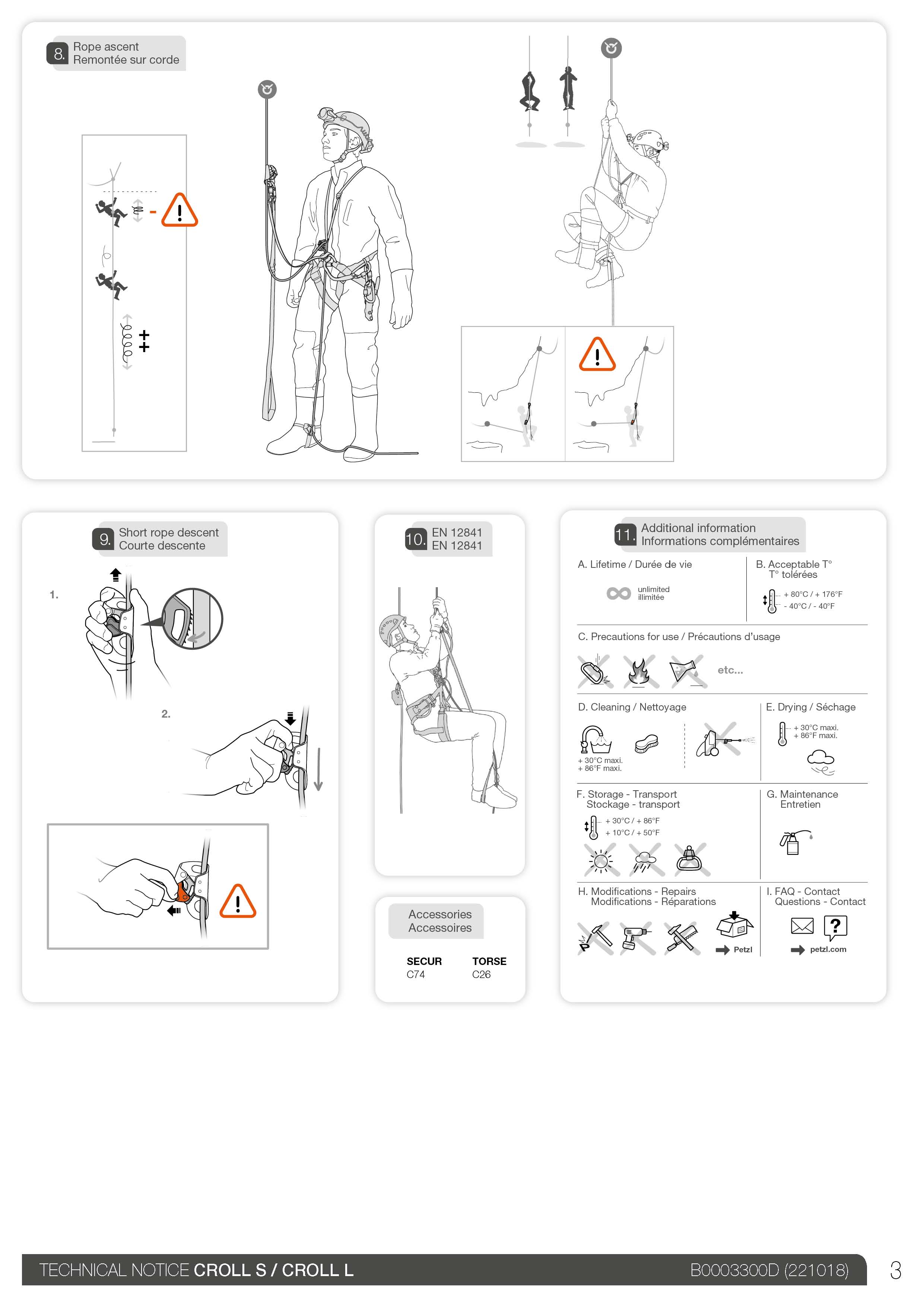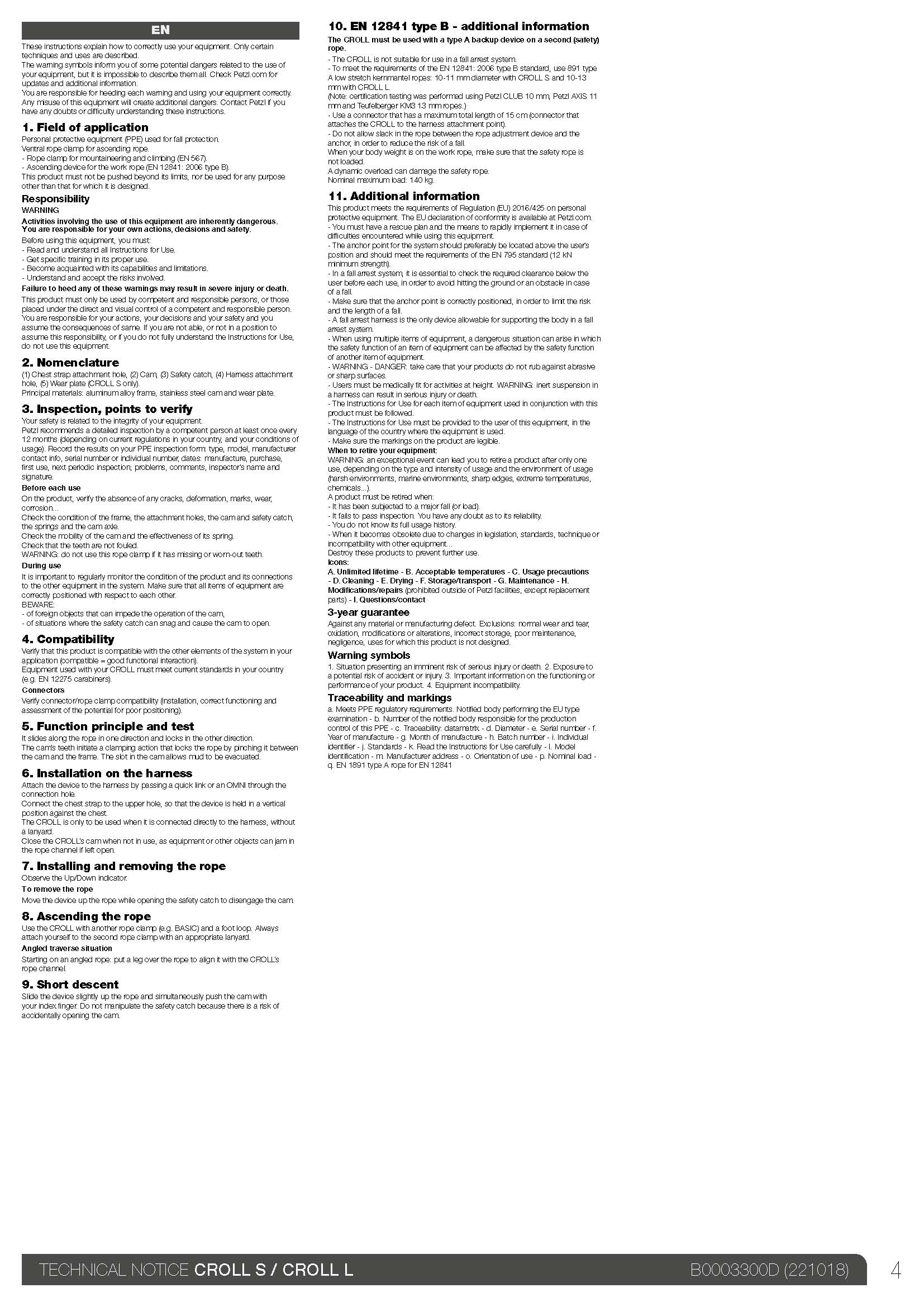Overview
Here is a quick summary of the versions in my collection:
- Cam with down-climbing flat, knob on safety.
(#1960, 2148)
- Anodized shell, pin on safety
(#10)
- New cam without flat, cam new safety
(#295)
- Cam slot, non-anodized D-shaped cam safety with auxiliary hole, round cam stop
(#11, 2147)
- Anodized D-shaped cam safety without auxiliary hole.
(#3517)
- Elongated upper hole cam safety not anodized.
(#214)
- Anodized cam safety
(#3613)
- Adds CE certification
(#215)
- Anodized cam safety
(#237, 3466)
- New shell design, stamped cam stop, new cam, plastic safety
(#126, 2081)
- New extended shell design
(#193)
- Printed markings
(#2080)
- Slot for 43 mm. webbing
(#2371)
- Complete redesign, much smaller
(#1965, 2064)
- Complete redesign, larger.
(#2372)
[ Top
| Version B
| Version C
| Version D
| Version E
| Version F
| Version G
| Version H
]
[ Version I
| Version J
| Version K
| Version L
| Version M
| Version N
| Version O
| Return to E.C. Ascenders
]
Version A
(#1960, 2148)
Technical Details
I acquired my this ascender from Bob Thrun at the 2013 Old Timers Reunion, and a second as part of Bob Thrun's Collection in 2017.
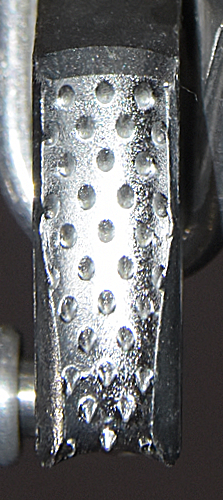 The ascender is left-handed, as are all Crolls I have seen.
The ascender is 117 mm. high, 75 mm. wide, 36 mm.
thick, and weighs 135 grams. The ascender shell is subtriangular
shape bent from 4.2 mm. aluminum sheet and clear anodized. The
rope channel is formed by bending the right side of the ascender
into a U. The rope channel is 15 mm. wide. The main sling attachment point is located below the cam and behind the
rope channel. A second attachment point is located above the cam,
also behind the rope channel. The shell is bent backwards at both
points to provide clearance between the attachment slings and
the main rope. This accounts for the rather large thickness of
this ascender. The attachment points appear to be circles distorted
by the stamping operation. The lower attachment point measures
16.5 by 13.8 mm. and the upper 16.8 by 13.2 mm. The left side
of the shell is bent on an inclined axis to form another U. A
hole drilled through both sides of the U accepts a semi-tubular rivet.
The cam and cam spring are mounted on this rivet. The head of
the rivet sits in a stamped depression on the back of the cam,
while the roll is exposed on the open side. The pivot is centered
49 mm. from the inside of the rope channel.
The ascender is left-handed, as are all Crolls I have seen.
The ascender is 117 mm. high, 75 mm. wide, 36 mm.
thick, and weighs 135 grams. The ascender shell is subtriangular
shape bent from 4.2 mm. aluminum sheet and clear anodized. The
rope channel is formed by bending the right side of the ascender
into a U. The rope channel is 15 mm. wide. The main sling attachment point is located below the cam and behind the
rope channel. A second attachment point is located above the cam,
also behind the rope channel. The shell is bent backwards at both
points to provide clearance between the attachment slings and
the main rope. This accounts for the rather large thickness of
this ascender. The attachment points appear to be circles distorted
by the stamping operation. The lower attachment point measures
16.5 by 13.8 mm. and the upper 16.8 by 13.2 mm. The left side
of the shell is bent on an inclined axis to form another U. A
hole drilled through both sides of the U accepts a semi-tubular rivet.
The cam and cam spring are mounted on this rivet. The head of
the rivet sits in a stamped depression on the back of the cam,
while the roll is exposed on the open side. The pivot is centered
49 mm. from the inside of the rope channel.
The cam is a plated skeletonized steel casting. The cam radius,
measured from the pivot, increases from 38 to 51 mm. over an angle of 36°, giving a 25° cam angle. The cam has number of small conical teeth,
all of which have their axes approximately parallel to the lower
surface of the cam. The tooth pattern is (F)(3.4)^3(3.2)^2(3). The
F stands for a short flat area designed to allow the user to cant
the ascender and slide it down the rope without opening the cam.
A spring-loaded manual safety bar is mounted on the bottom of
the cam with a steel semi-tubular rivet. The normal action
of the spring holds the safety against the cam. When the cam is
opened, the shell interferes with the safety bar, thus preventing
opening the cam. If the safety bar is moved away from the cam
(opposing the spring), it will clear the shell and the cam will
open. At full open the safety can be released and the spring will
hold the safety against the back of the shell. This provides a
means of locking the cam open. A knob on the safety
bar assists in operating the safety mechanism.
The
back of the shell is stamped with the logo "F.PETZL" inside an oval and "FRANCE."
The Croll can be used in almost any situation where other handleless
eccentric cam ascenders are used. The Croll was designed as a
chest ascender for the Frog System, and is particularly applicable
to that system. It serves very well as a floating knee ascender
in rope-walking rigs. The teeth are oriented more steeply than
on the CMI Shorti III or the Kong-Bonaiti
Cam-Clean, so the advantages of inclined teeth discussed there
are even more applicable here.
The flat area on the cam caused some confusion. Some cavers
thought it was a design defect, but actually it was provided as
a feature. The flat area allows one to cant the ascender then
slide it down the rope without opening the cam. This feature was
later abandoned.
Single-handed operation of the Croll is rather difficult. Right-handed
operation of this left-handed ascender is particularly difficult.
When used in frog system (for which the Croll is designed), these
comments don't really matter since the harness serves the purpose
of a second hand. Closing a locked open ascender is much easier than opening, since
the strong cam spring assists the user.
In general I feel that this is a well made ascender. All sharp
edges have been removed. The cam teeth are very well done. The
attachment points are simply holes in the shell, and although
well rounded I consider their small radius too sharp for directly
attaching sling ropes. They are probably acceptably rounded for
webbing, but considering the proximity of the attachment points
to the main rope, I recommend using a maillon for
the lower attachment in order to reduce the risk of sling abrasion. In the Frog System, one would do that anyhow.
[ Top
| Version A
| Version C
| Version D
| Version E
| Version F
| Version G
| Version H
]
[ Version I
| Version J
| Version K
| Version L
| Version M
| Version N
| Version O
| Return to E.C. Ascenders
]
Version B
(#10)
Technical Details
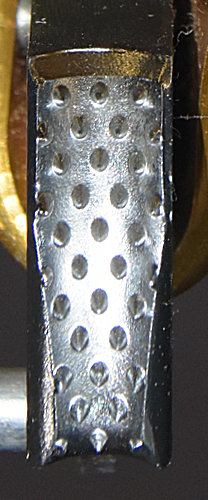 I obtained this Petzl Croll ascender from Speleoshoppe in
1979.
I obtained this Petzl Croll ascender from Speleoshoppe in
1979.
This version is 117 mm. tall, 76 mm. wide, 38 mm. thick, and weighs 137 g. The rope channel is 15 mm. wide. The cam radius increases from 38 to 51 mm. over an angle of 36°, giving a 25° cam angle. The tooth pattern is (F)(3.4)^3(3.2)^2(3). A cam safety pin replaces the knob on the previous version, the shell is gold anodized, and the markings differ; otherwise, the two are essentially identical.
The
back of the shell is stamped with the logo "PETZL" inside an oval, "MAXI 400
KG," "BREVETE," and "FRANCE."
The gold anodized shell is a cosmetic improvement.
[ Top
| Version A
| Version B
| Version D
| Version E
| Version F
| Version G
| Version H
]
[ Version I
| Version J
| Version K
| Version L
| Version M
| Version N
| Version O
| Return to E.C. Ascenders
]
Version C
(#295)
Technical Details
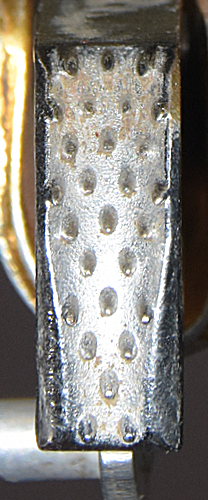 I acquired this version used from Bruce Ellison in 2009. It dates from the early- to mid-1980s.
I acquired this version used from Bruce Ellison in 2009. It dates from the early- to mid-1980s.
Version C is 119 mm. tall, 76 mm. wide, 37 mm. thick, and weighs 136 g. The shell is similar to the one on the previous version, but the cam design is new. The tooth pattern is (3.4)^2(3.2)^2(1.2), eliminating the flat area above the teeth. The safety has a new shape as well.
The rear of the shell is stamped with "PETZL" inside an oval, "MAXI 400KG, "BREVETE," and "FRANCE." The word "PETZL" is cast into both sides of the cam. Both sides of the safety are stamped with "OIL" and an arrow pointing at the safety pivot.
The normal rigging for a chest ascender does not allow tilting it for down-climbing, so eliminating the flat area on the cam shouldn't affect operation.
[ Top
| Version A
| Version B
| Version C
| Version E
| Version F
| Version G
| Version H
]
[ Version I
| Version J
| Version K
| Version L
| Version M
| Version N
| Version O
| Return to E.C. Ascenders
]
Version D
(#11, 2147)
Technical Details
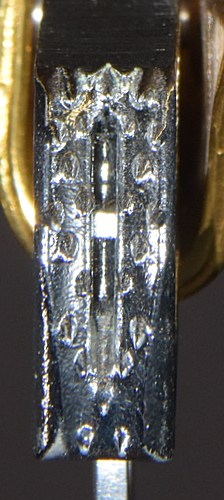 I acquired this Petzl Croll ascender from Bob & Bob
at the 1988 NSS convention. I acquired another in 2017 as part of Bob Thrun’s collection.
I acquired this Petzl Croll ascender from Bob & Bob
at the 1988 NSS convention. I acquired another in 2017 as part of Bob Thrun’s collection.
This ascender is 119 mm. high, 76 mm. wide, 39 mm.
thick, and weighs 138 grams. This ascender has only minor
shell variations over the previous versions. The lower attachment point
measures 21 by 19.5 mm. and the upper 15.5 by 13 mm. A small
cylinder riveted to the shell acts as a cam closing stop.
The cam is a revised skeletonized casting, plated as before.
The cam radius, measured from the pivot, increases from 40 to
53 mm. over an angle of 37 degrees. The cam has number of
small conical teeth, all of which have their axes approximately
parallel to the upper surface of the cam. The cam has number of
small conical teeth, all of which have their axes approximately
parallel to the lower surface of the cam. The tooth pattern is
(2.3)(2S2.1S1)^2(1S1)^3(1.2), where the "S"s stand for
a single longitudinal slot designed for mud removal. The spring-loaded
manual safety bar has been enlarged to a 36 mm. semicircle.
The back of the shell is stamped "PETZL," "MAXI
400 KG," "BREVETE FRANCE," "CORDE," "ROPE,"
"Ø mm. " and "10 m/m." A Sieg
Heil icon is stamped onto the front. The word "PETZL"
is cast into both sides of the cam.
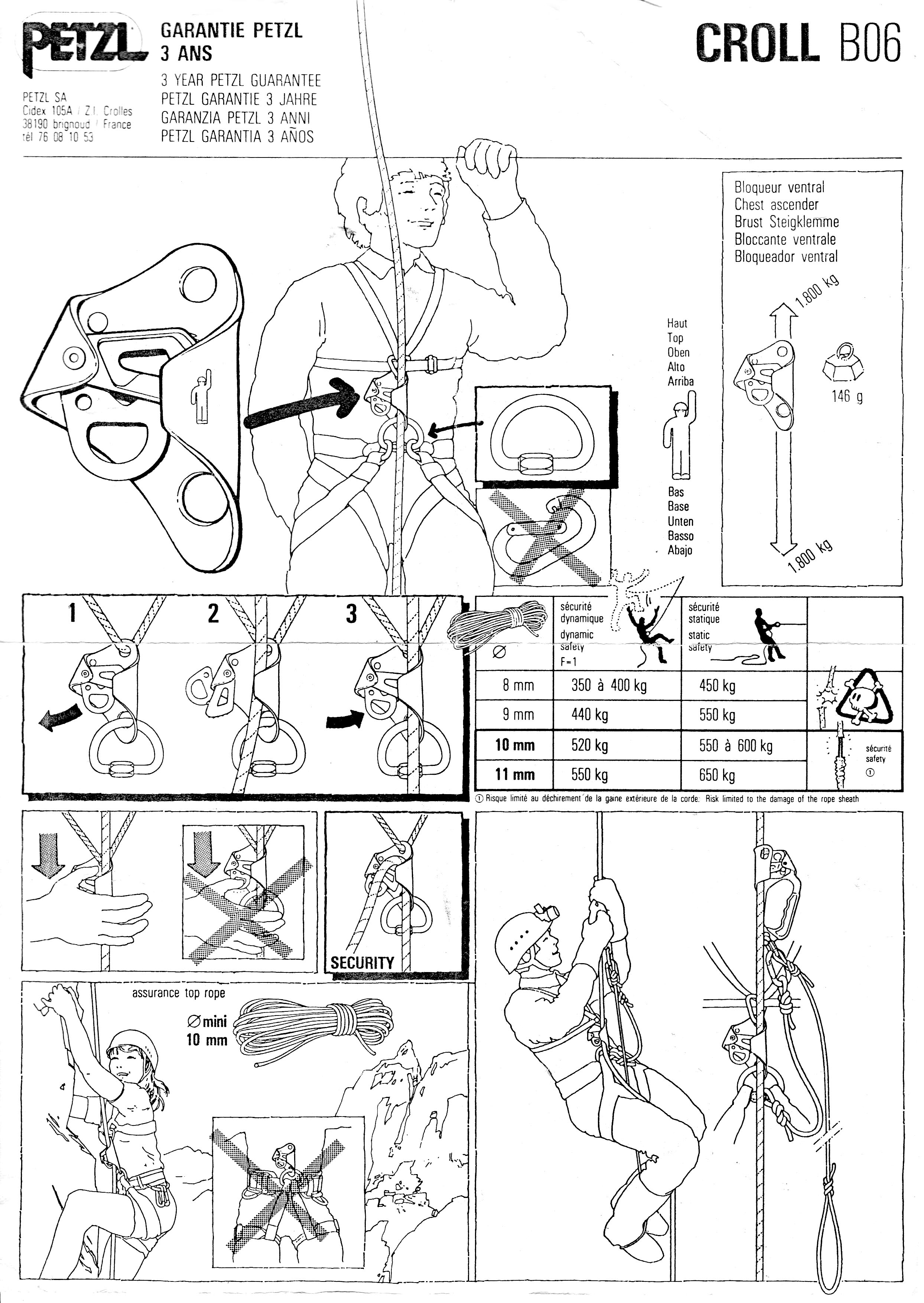 The enlargement of the lower attachment hole is an improvement, but the reduction of the upper is not. The enlarged safety is too big for my taste, and the ascender is still difficult to operate one-handed. The human figure shows which way is up for certain uses, but anyone who needs this assistance shouldn't be using the ascender anyhow. Petzl’s literature shows their ascenders being used in hauling systems, in which case the figure is upside
down.
The enlargement of the lower attachment hole is an improvement, but the reduction of the upper is not. The enlarged safety is too big for my taste, and the ascender is still difficult to operate one-handed. The human figure shows which way is up for certain uses, but anyone who needs this assistance shouldn't be using the ascender anyhow. Petzl’s literature shows their ascenders being used in hauling systems, in which case the figure is upside
down.
The workmanship of the cam does not appear to be as good as on Version B, but is certainly adequate. The cam closing stop is nonfunctional since the cam face hits the rope channel before the top of the cam hits the stop. The slot in the cam is intended to reduce the risk of ascender slippage due to mud-caked cam teeth. The design appears superior to the holes on the Kong-Bonaiti Cam-Clean, but the slot is too small and it is obstructed by a reinforcing rib. Like the Kong-Bonaiti, I believe that most ropes muddy enough to stop other ascenders will stop the this one too. Although I have not tried this ascender in the appropriate conditions, I suspect that the slot will not eliminate the icing problems common to other toothed cam ascenders.
[ Top
| Version A
| Version B
| Version C
| Version D
| Version F
| Version G
| Version H
]
[ Version I
| Version J
| Version K
| Version L
| Version M
| Version N
| Version O
| Return to E.C. Ascenders
]
Version E
(#3517)
Technical Details
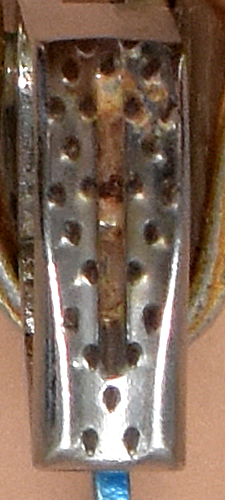 I acquired my Petzl Croll, Version E from Josep Guarro in 2022. It dates from the late 1980s or early 1990s.
I acquired my Petzl Croll, Version E from Josep Guarro in 2022. It dates from the late 1980s or early 1990s.
The ascender is 119 mm. high, 76 mm. wide, 36 mm.
thick, and weighs 145 grams. This ascender has only minor
shell variations over the previous versions. The lower attachment point
measures 21 by 19.5 mm. and the upper 15.5 by 13 mm. A small
cylinder riveted to the shell acts as a cam closing stop. The rope channel is 15 mm. wide. The cam axle is centered 47 mm. from the inside of the rope channel.
The cam is a skeletonized casting, plated as before.
The cam radius, measured from the pivot, increases from 38 to 52
mm. over an angle of 37 degrees, giving a 25° cam angle. The cam has number of
small conical teeth, all of which have their axes approximately
parallel to the upper surface of the cam. The cam has number of
small conical teeth, all of which have their axes approximately
parallel to the lower surface of the cam. The tooth pattern is
(2.3)(2S2.1S1)^2(1S1)^3(1.2), where the "S"s stand for
a single longitudinal slot designed for mud removal. The spring-loaded
manual safety bar has a 36 mm. semicircular finger tab.
The back of the shell is stamped with the
PETZL logo, "BREVETE FRANCE," and the UIAA logo. A Sieg
Heil icon is stamped onto the front. The word "PETZL"
is cast into both sides of the cam.
This is an intermediate version with only minor changes. The upper attachment hole has been enlarged slightly compared to Version D, but will be redesigned for Version F.
The hole in the cam safety was removed, and the safety anodized blue. Omitting the small hole in the cam safety
has no practical significance.
[ Top
| Version A
| Version B
| Version C
| Version D
| Version E
| Version G
| Version H
]
[ Version I
| Version J
| Version K
| Version L
| Version M
| Version N
| Version O
| Return to E.C. Ascenders
]
Version F
(#214)
Technical Details
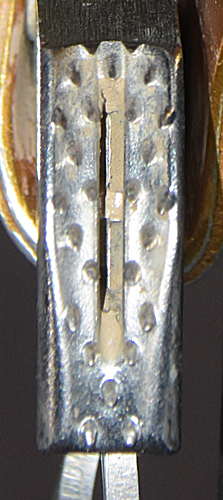 I acquired this Petzl Croll ascender used from Andy Dopson
in 2007. It dates from 1995.
I acquired this Petzl Croll ascender used from Andy Dopson
in 2007. It dates from 1995.
This ascender is 119 mm. high, 77 mm. wide, 37 mm.
thick, and weighs 142 grams. This ascender a larger upper
hole than in earlier versions. This hole is a 23.1 mm. long, 15.8 mm.
wide inclined oval. The remainder of the shell is essentially
identical to the Version C shell.
The cam is essentially identical to the previous version cam,
but the cam safety omits the small hole.
The back of the shell is stamped with "09495A," the
PETZL logo, "BREVETE FRANCE," and the UIAA logo. A Sieg
Heil icon is stamped onto the front. The word "PETZL"
is cast into both sides of the cam.
Version F and Version H are essentially the same, except for their markings. Version F does not claim to have CE approval.
The enlargement of the upper attachment hole is an improvement
over earlier versions. The cam closing stop is now almost
functional, since the the top of the cam hits the stop at the
same time that the cam face hits the rope channel.
[ Top
| Version A
| Version B
| Version C
| Version D
| Version E
| Version F
| Version H
]
[ Version I
| Version J
| Version K
| Version L
| Version M
| Version N
| Version O
| Return to E.C. Ascenders
]
Version G
(#3613)
Technical Details
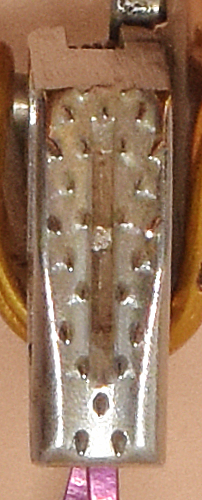 I acquired this Petzl Croll ascender used from Cheryl Clementi
in 2023. It dates from 1993.
I acquired this Petzl Croll ascender used from Cheryl Clementi
in 2023. It dates from 1993.
This ascender is 119 mm. high, 78 mm. wide, 38 mm.
thick, and weighs 146 grams. The rope channel is 15 mm. wide. The cam axle is centered 49 mm. from the inside of the rope channel. The cam radius, measured from the axle axis, increases from 37 to 53 mm. over an angle of 37°, giving a 29° cam angle. The tooth pattern is (2.3)(2S2.1S1)^2(1S1)^3(1.2).
The back of the shell is stamped with "02893A," the
PETZL logo, "BREVETE FRANCE," and the UIAA logo. A Sieg
Heil icon is stamped onto the front. The word "PETZL"
is cast into both sides of the cam.
Version F and Version G are essentially the same, but the cam safety on Version G is anodized while the one on Version F is not.
[ Top
| Version A
| Version B
| Version C
| Version D
| Version E
| Version F
| Version G
]
[ Version I
| Version J
| Version J
| Version K
| Version L
| Version M
| Version N
| Version O
| Return to E.C. Ascenders
]
Version H
(#215)
Technical Details
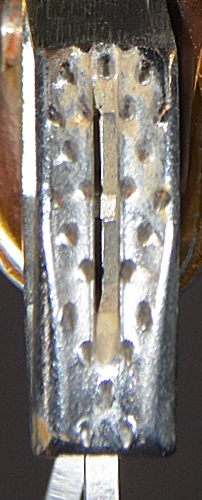 I acquired this Petzl Croll ascender used from Andy Dopson
in 2007. It dates from 1996.
I acquired this Petzl Croll ascender used from Andy Dopson
in 2007. It dates from 1996.
This ascender is 119 mm. high, 78 mm. wide, 38 mm.
thick, and weighs 142 grams. It is essentially identical
to Version F except for the markings on the back of the
shell.
The back of the shell is stamped with "96026A," the
UIAA logo, "ROPES Ø8-13mm," the PETZL logo, "BREVETE
FRANCE," and "CE950082." A Sieg
Heil icon is stamped onto the front. The word "PETZL"
is cast into both sides of the cam.
Version F and Version H are essentially the same, except for their markings. Version H has CE approval.
The enlargement of the lower attachment hole is an improvement,
but the reduction of the upper is not. The enlarged safety is
too big for my taste, and the ascender is still difficult to operate
one-handed. The human figure shows which way is up for certain
uses, but anyone who needs this assistance shouldn't be using
the ascender anyhow. Petzl’s literature shows their ascenders
being used in hauling systems, in which case the figure is upside
down.
The workmanship of the cam does not appear to be as good as
on some preceding versions, but is certainly adequate. The cam closing
stop is nonfunctional since the cam face hits the rope channel
before the top of the cam hits the stop. The slot in the cam is
intended to reduce the risk of ascender slippage due to mud-caked
cam teeth. The design appears superior to the holes on the Kong-Bonaiti Cam-Clean, but the slot is too
small and it is obstructed by a reinforcing rib. Like the Kong-Bonaiti, I believe that most ropes muddy
enough to stop other ascenders will stop the this one too. Although
I have not tried this ascender in the appropriate conditions,
I suspect that the slot will not eliminate the icing problems
common to other toothed cam ascenders.
[ Top
| Version A
| Version B
| Version C
| Version D
| Version E
| Version F
| Version G
| Version H
]
[ Version J
| Version K
| Version L
| Version M
| Version N
| Version O
| Return to E.C. Ascenders
]
Version I
(#237, 3466)
Technical Details
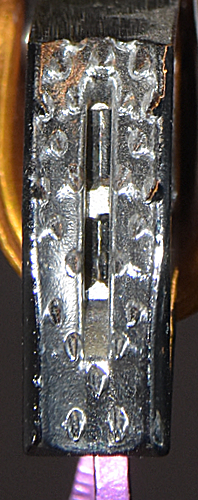 I acquired this Petzl Croll ascender used on eBay from Ross
Strother in 2008. It dates from 1997. On Rope 1 donated another, dating from 1996, in 2021.
I acquired this Petzl Croll ascender used on eBay from Ross
Strother in 2008. It dates from 1997. On Rope 1 donated another, dating from 1996, in 2021.
This ascender is 119 mm. high, 81 mm. wide, 38 mm.
thick, and weighs 144 grams. It is essentially identical
to Version F and Version H except for the anodized safety and,
of course, the markings on the back of the shell.
The back of the shell is stamped with "97196C," the
UIAA logo, "ROPES Ø8-13mm," the PETZL logo, "BREVETE
FRANCE," and "CE950082." A Sieg
Heil icon is stamped onto the front. The word "PETZL"
is cast into both sides of the cam.
The anodized safety is a cosmetic improvement.
[ Top
| Version A
| Version B
| Version C
| Version D
| Version E
| Version F
| Version G
| Version H
]
[ Version I
| Version K
| Version L
| Version M
| Version N
| Version O
| Return to E.C. Ascenders
]
Version J
(#126, 2081)
Technical Details
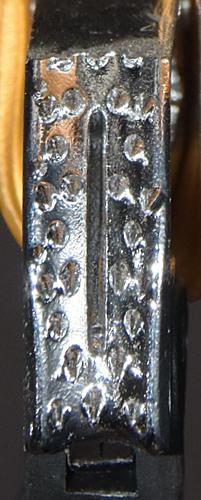 I acquired this Petzl Croll ascender new from Bob & Bob
at the 1998 NSS convention. I acquired another in 2017 as part of Bob Thrun’s collection.
I acquired this Petzl Croll ascender new from Bob & Bob
at the 1998 NSS convention. I acquired another in 2017 as part of Bob Thrun’s collection.
This version is 103 mm. tall, 70 mm. wide, 38 mm. thick, and weighs 130 g.
The frame is shorter than on the previous models, and Petzl changed to
a stamped cam closing stop. The rope channel is 14 mm. wide. The cam axle is centered 47 mm. from the inside of the rope channel.
Petzl also changed the cam. The cam uses a new tooth pattern with a strange odd tooth,
(3.1.4)(1S1.1S0.2S2)^2(1S1.2.3), and has a steeper cam angle.The cam radius, measured from the axle axis, increases from 37 to 54 mm. over an angle of 35°, giving a 31° cam angle. Petzl changed the cam safety to molded plastic.
The back of the shell is stamped with "98110A," "CE0197
EN567," the Reading is Dangerous
icon, the UIAA logo, and the Petzl logo. The front is stamped
with a Sieg Heil icon and
"ROPEO8Ø13." The Petzl logo is cast into
the cam.
Petzl shortened the ascender compared to earlier models. This made it more compact, but many people found that this version did not ride as well as the taller earlier models. Petzl soon corrected their error and extended the top hole on the next version.
This version uses a new cam design with some nicely-made
teeth and a thin, redesigned mud groove that has more clearance,
but still seems to be ineffective except in ideal situations.
The Croll remains difficult to use one-handed, but this is
more because the ascender is small than a criticism of the safety.
When used in frog system (for which the Croll is designed), this
comment doesn't really matter since the harness serves the purpose
of a second hand.
[ Top
| Version A
| Version B
| Version C
| Version D
| Version E
| Version F
| Version G
| Version H
| Version I
]
[ Version J
| Version L
| Version M
| Version N
| Version O
| Return to E.C. Ascenders
]
Version K
(#193)
Technical Details
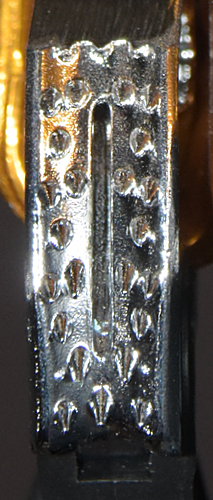 I acquired this Croll new from On Rope 1 at the 2006 NSS Convention.
I acquired this Croll new from On Rope 1 at the 2006 NSS Convention.
This version is 109 mm. tall, 75 mm. wide, 37 mm. thick, and weighs 133 g.
The frame is taller than on the previous model. The rope channel is 14 mm. wide. The cam axle is centered 47 mm. from the inside of the rope channel. The cam radius, measured from the axle axis, increases from 37 to 54 mm. over an angle of 35°, giving a 32° cam angle. The tooth pattern is (3.1.4)(1S1.1S0.2S2)^2(1S1.2.3).
The back of the shell is stamped with "05048I," "CE0197
EN567," the Reading is Dangerous
icon, the UIAA logo, and the Petzl logo. The front is stamped
with a Sieg Heil icon and
"ROPEO8Ø13." The Petzl logo is cast into
the cam.
Many people found that the previous version did not ride as well as the taller earlier models. Petzl corrected their error and extended the top hole on this version, allowing it to ride better when used in a frog system.
[ Top
| Version A
| Version B
| Version C
| Version D
| Version E
| Version F
| Version G
| Version H
]
[ Version I
| Version J
| Version K
| Version M
| Version N
| Version O
| Return to E.C. Ascenders
]
Version L
(#2080)
Technical Details
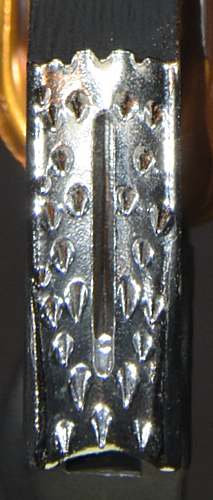 I acquired this Petzl Croll ascender in 2017 as part of Bob Thrun’s collection. It dates from 2009.
I acquired this Petzl Croll ascender in 2017 as part of Bob Thrun’s collection. It dates from 2009.
This version is 109 mm. tall, 75 mm. wide, 37 mm. thick, and weighs 132 g. The rope channel is 14 mm. wide. The cam axle is centered 47 mm. from the inside of the rope channel. The cam radius, measured from the axle axis, increases from 37 to 54 mm. over an angle of 35°, giving a 32° cam angle. The tooth pattern is (3.1.4)(1S1.1S0.2S2)^2(1S1.2.3).
The front is stamped
with the Petzl logo, an up-pointing arrow labeled "UP," "CROLL," and a book-with-an-"I" icon. The back of the cam is printed with "09020F s7740," a scanner code, "CE0197," "EN567:1997," "O 8Ø13mm, "EN12841:2006B," "O 10Ø13mm, "100kg," the UIAA logo, and "Made in France."
Aside from the markings, and in particular, printed instead of stamped markings on the rear, this is essentially the same as the previous version.
|
 |
Warning:
The weight ("100kg") printed on the SHELL can easily be
less than the weight of a fully loaded caver. |
 |
|
[ Top
| Version A
| Version B
| Version C
| Version D
| Version E
| Version F
| Version G
| Version H
]
[ Version I
| Version J
| Version K
| Version L
| Version N
| Version O
| Return to E.C. Ascenders
]
Version M
(#2371)
Technical Details
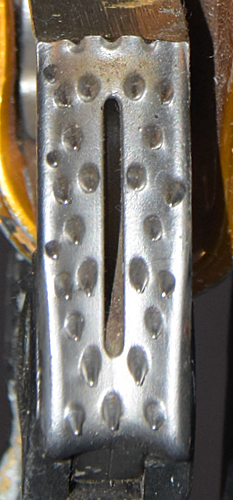 I acquired this Croll from Stacey Sims of Leather and Lacy Acres in 2018.
I acquired this Croll from Stacey Sims of Leather and Lacy Acres in 2018.
This version is 109 mm. tall, 78 mm. wide, 37 mm. thick, and weighs 238 g. (including the strap and D-ring). The rope channel is 15 mm. wide. The shell
stamped from 3.9 mm. aluminum. The back is
not flat; instead, the upper and lower portions of the shell bend backward.
The upper attachment hole is a 44 mm. wide, 5.2 mm. high slot. A length of black 43 mm. webbing sewn to this slot connects to a bent D-ring that sits 48 mm. above the shell. The lower attachment hole
is 18.2 mm. wide and 17.9 mm. high.
The cam and cam safety match those on Version L.
The front of the shell is stamped with the Petzl logo, an up-pointing arrow with "UP" inside, and a book-with-an-"i" icon.
"CROLL" and "Pat." The inside of the shell has a stamped book-with-an-"i" icon. The rear is printed with "13079FF0795," "CE0082," EN12847:2006B•," "Ø10-13mm," "100 kg," "Made in France," and "C71100." A previous owner added "003 AP" and :141." The Petzl
logo is cast into the cam. The D-ring is stamped "PETZL."
This version appears to have been intended for industrial use, as the webbing and D-ring are clearly not designed for an efficient Frog system. The stitching is interesting: the center row has a machine-made zigzag pattern, but the top and bottom rows appear to have been added by a previous owner, stitched with a hand awl using waxed thread. The top row is irregular while the bottom row is neat.
[ Top
| Version A
| Version B
| Version C
| Version D
| Version E
| Version F
| Version G
| Version H
]
[ Version I
| Version J
| Version K
| Version L
| Version M
| Version O
| Return to E.C. Ascenders
]
Version N
(#1965, 2064)
Technical Details
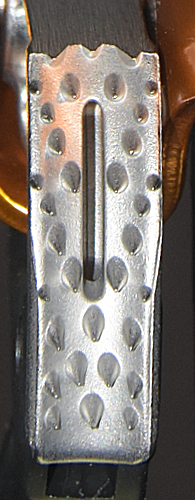 I acquired this Croll from On Rope 1 in 2013.
I acquired this Croll from On Rope 1 in 2013.
This version is 97 mm. tall, 58 mm. wide, 30 mm. thick, and weighs 83 g. The rope channel is 13 mm. wide. The shell
was completely redesigned to be considerably smaller than in previous versions. It is stamped from 2.9 mm. aluminum. The back is
not flat; instead, the upper and lower portions of the shell bend backward.
The upper attachment hole is 23.2 mm. wide and 14.3 mm. high. The lower attachment hole
is 21.5 mm. wide and 21.1 mm. high. The front inside of the rope channel is lined with a wear guard stamped from 1.1 mm. stainless steel and attached to the front of the rope channel with two rivets.
The cam is also new, and smaller than on previous models. The cam axle is only 34 mm. from the inside of the rope channel, as opposed to 47-50 mm. on earlier versions. The cam is cast from stainless steel with a web design. The cam radius increases from 24 to 45 mm. over an angle of 47°, giving a 38° cam angle. The tooth pattern is (3.4)((1S1)^2.2S2)^2(3.4.3). The injection-molded plastic cam safety
has a new shape as well, and is correspondingly smaller. Like on other versions of the Croll, the cam
safety can hook over the cam channel to hold the cam open.
The front of the shell is stamped with an up-pointing arrow labeled "UP," "CROLL" and "Pat." The inside of the shell has a stamped book-with-an-"i" icon. The rear is printed with "CE0082," EN567;1997" "•Ø8-11mm," " EN12841:2006B," "•Ø10-11mm140kg," the UIAA logo, a digital scanner code, and"Made in France." The Petzl
logo is cast into the cam.
This version is considerable smaller and lighter than previous versions. This makes it somewhat more difficult to operate, particularly if I am wearing gloves.
 There have been discussions on the UK caving board and on Facebook about the shell liner wearing quickly and in an unpredictable manner, leading to rope damage. I have not used mine enough to assess the seriousness of this concern. If you choose this ascender for your rig, you should find the relevant posts, evaluate the concern posted there, and then take any appropriate precautions.
There have been discussions on the UK caving board and on Facebook about the shell liner wearing quickly and in an unpredictable manner, leading to rope damage. I have not used mine enough to assess the seriousness of this concern. If you choose this ascender for your rig, you should find the relevant posts, evaluate the concern posted there, and then take any appropriate precautions.
[ Top
| Version A
| Version B
| Version C
| Version D
| Version E
| Version F
| Version G
| Version H
]
[ Version I
| Version J
| Version K
| Version L
| Version M
| Version N
| Return to E.C. Ascenders
]
Version O
(#2372)
Technical Details
I acquired this Croll from On Rope 1 at the 2018 NSS Convention.
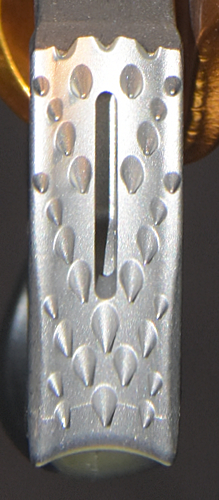 This version is 110 mm. tall, 79 mm. wide, 41 mm. thick, and weighs 138 g. The rope channel is 16 mm. wide. The shell
was completely redesigned to be considerably smaller than in previous versions. It is stamped from 2.9 mm. aluminum. The back is
not flat; instead, the upper and lower portions of the shell bend backward.
The upper attachment hole is 23.2 mm. wide and 14.3 mm. high. The lower attachment hole
is 21.5 mm. wide and 21.1 mm. high. The front inside of the rope channel is lined with a wear guard stamped from 1.1 mm. stainless steel and attached to the front of the rope channel with two rivets.
This version is 110 mm. tall, 79 mm. wide, 41 mm. thick, and weighs 138 g. The rope channel is 16 mm. wide. The shell
was completely redesigned to be considerably smaller than in previous versions. It is stamped from 2.9 mm. aluminum. The back is
not flat; instead, the upper and lower portions of the shell bend backward.
The upper attachment hole is 23.2 mm. wide and 14.3 mm. high. The lower attachment hole
is 21.5 mm. wide and 21.1 mm. high. The front inside of the rope channel is lined with a wear guard stamped from 1.1 mm. stainless steel and attached to the front of the rope channel with two rivets.
The cam is also new, and smaller than on previous models. The cam axle is only 34 mm. from the inside of the rope channel, as opposed to 47-50 mm. on earlier versions. The cam is cast from stainless steel with a web design. The cam radius increases from 38 to 55 mm. over an angle of 35°, giving a 32° cam angle. The tooth pattern is (3.4)(1S1)^2(2S2)(1S1)^4(3.4.3). The injection-molded plastic cam safety
has a new shape as well, and is correspondingly smaller. Like on other versions of the Croll, the cam
safety can hook over the cam channel to hold the cam open.
The front of the shell is stamped with an up-pointing arrow labeled "UP" and "CROLL." The rear is printed with "CROLL L," "CE0082," a book-with-an-"i" icon, "EAC," "TP/TC," 019/2011," "EN12841:2006 B•Ø10-13mm140kg," "EN567:2013 Ø8-13mm," the UL Classified logo, "MEETS NFPA 1983 (2017 Ed.)," "FOR ROPE 11≤Ø≤13 mm," "T," a scanner code, and "18D0132579996." The Petzl
logo is cast into the cam.
Version N was poorly received, and so Petzl introduced the Croll L, returning to the size of the traditional Crolls. This version resembles Version L, but has a thicker shell and no cam stop.
The markings show the sad state of ascender standards worldwide. The EN567 test validated this ascender’s use on 8-13 mm. ropes, the EN12841 test only accepted 10-13 mm., and the NFPA test approved 11-13 mm. ropes. Some of this must be to please the Bigger is Better crowd; meanwhile, Petzl recommends using 11-13 mm. ropes while most cavers use 9-11 mm. ropes.
[ Top
| Version A
| Version B
| Version C
| Version D
| Version E
| Version F
| Version G
| Version H
]
[ Version I
| Version J
| Version K
| Version L
| Version M
| Version N
| Version O
]



 Comments
Comments The enlargement of the lower attachment hole is an improvement, but the reduction of the upper is not. The enlarged safety is too big for my taste, and the ascender is still difficult to operate one-handed. The human figure shows which way is up for certain uses, but anyone who needs this assistance shouldn't be using the ascender anyhow. Petzl’s literature shows their ascenders being used in hauling systems, in which case the figure is upside
down.
The enlargement of the lower attachment hole is an improvement, but the reduction of the upper is not. The enlarged safety is too big for my taste, and the ascender is still difficult to operate one-handed. The human figure shows which way is up for certain uses, but anyone who needs this assistance shouldn't be using the ascender anyhow. Petzl’s literature shows their ascenders being used in hauling systems, in which case the figure is upside
down.